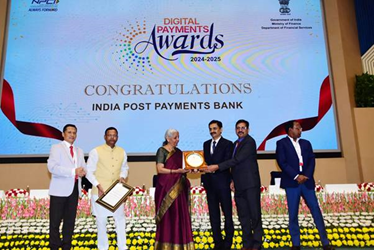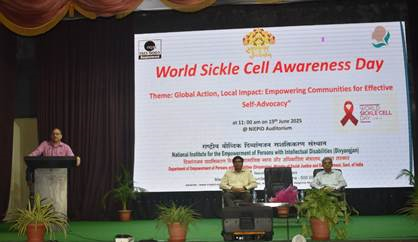Topic- 1: Digital Payments Award
GS-3: Economy
The context:
India Post Payments Bank (IPPB), a 100% Government of India-owned entity under the Department of Posts, Ministry of Communications, has been conferred the prestigious Digital Payments Award 2024-25 by the Department of Financial Services (DFS), Ministry of Finance, in recognition of its outstanding contribution to expanding digital payments and financial inclusion across the country.
The Key Highlights:
-
- The award was presented by the Hon’ble Union Minister of Finance & Corporate Affairs, IPPB at a ceremony held in New Delhi.
- India Post Payments Bank (IPPB) achieved 1stPosition among Payments Banks in India in the Performance Index for Financial Year 2024–25 & received ‘Special Mention’ award for the Financial Year 2023-24. This leap reflects the IPPB’s robust capabilities and its unwavering commitment to delivering inclusive, technology-led, citizen-centric banking solutions with a purpose.
- It was established with the vision of driving financial inclusion at scale, IPPB has emerged as one of the largest platforms for digital banking in India, leveraging the unmatched reach of the Department of Posts network. With a robust tech-driven architecture and a doorstep banking model powered by over 2 lakh Postmen and Gramin Dak Sevaks, IPPB has been pivotal in promoting digital payments even in the remotest parts of the country.
- This award is a testimony to IPPB’s relentless efforts in making digital financial services accessible, inclusive, and trusted. We are honoured by this recognition and remain committed to empowering every Indian citizen through innovative and secure digital banking solutions.
- This recognition underscores IPPB’s mission to bridge the urban-rural divide in banking and reaffirm its role as a key enabler in the Government’s vision of a cash-light, digitally empowered economy.

About India Post Payments Bank
-
- India Post Payments Bank (IPPB) has been established under the Department of Posts, Ministry of Communication with 100% equity owned by Government of India.
- IPPB was launched on September 1, 2018.
- The bank has been set up with the vision to build the most accessible, affordable and trusted bank for the common man in India.
- The fundamental mandate of India Post Payments Bank is to remove barriers for the unbanked & underbanked and reach the last mile leveraging the Postal network comprising ~1,65,000 Post Offices (~140,000 in rural areas) and ~3,00,000 Postal employees.
- IPPB’s reach and its operating model is built on the key pillars of India Stack – enabling Paperless, Cashless and Presence-less banking in a simple and secure manner at the customers’ doorstep, through a CBS-integrated smartphone and biometric device. Leveraging frugal innovation and with a high focus on ease of banking for the masses, IPPB delivers simple and affordable banking solutions through intuitive interfaces available in 13 languages to 11 Crore customers across 5.57 lakh villages & towns in India.
- IPPB is committed to provide a fillip to a less cash economy and contribute to the vision of Digital India. India will prosper when every citizen will have equal opportunity to become financially secure and empowered. Our motto stands true – Every customer is important, every transaction is significant and every deposit is valuable.
Source: PIB
Topic- 2: PM Surya Ghar: Muft Bijli Yojana (PMSGMBY)
GS-3: Economy
The context:
The Ministry of New and Renewable Energy (MNRE) launched the City Accelerator Program on 19th June 2025 during the National Conference on Skill Development for Renewable Energy Workforce held at Atal Akshay Urja Bhawan, New Delhi. The program is being implemented in collaboration with Shakti Sustainable Energy Foundation (SSEF).
-
- The City Accelerator Program is a key initiative under the PM Surya Ghar: Muft Bijli Yojana (PMSGMBY), the world’s largest domestic rooftop solar (RTS) scheme, and aims to drive faster adoption of RTS across Indian cities.
- In its first phase, the program will be rolled out in 30 cities across 10 states. Insights gained during this phase will inform the subsequent expansion to 100 cities.
The program is designed to provide:
-
- Technical assistance to Urban Local Bodies (ULBs) and DISCOMs
- Capacity building and institutional strengthening
- Support in designing enabling city-level policy and regulatory frameworks
About the PM Surya Ghar: Muft Bijli Yojana (PMSGMBY):
-
- The PM Surya Ghar: Muft Bijli Yojana, launched by the Government of India, seeks to solarise 1 crore households and is a critical part of India’s commitment to achieving 500 GW of renewable energy capacity by 2030.
- The City Accelerator Program supports this vision by targeting urban areas—key hubs of energy consumption—with a focused and structured approach.
- The program aims to build institutional capacity, improve economic understanding of rooftop solar benefits for stakeholders like DISCOMs and ULBs, and foster policy innovation through collaboration and knowledge sharing.
Key Objectives of the Program:
-
- Identify and resolve city-level barriers to RTS adoption through technical assistance.
- Develop economic models and tools to demonstrate benefits to stakeholders.
- Support targeted awareness, skill development, and outreach campaigns.
- Create and disseminate toolkits, knowledge products, and success stories.
- Advise cities on enabling policy reforms and innovative business models.
- Facilitate collaboration among city administrators, DISCOMs, and State Nodal Agencies (SNAs).
A dedicated cell has been set up at MNRE, and teams will be deployed with implementation agencies in each city to ensure effective on-ground support and monitoring. By building solar-ready cities and creating replicable models, the City Accelerator Program aims to transform India’s urban energy landscape and contribute meaningfully to its clean energy transition.
Source: PIB
Topic- 3: The World Sickle Cell Day 2025
GS-3: Science and Technology
The context:
On 19th June 2025, the D/o Empowerment of Persons with Disabilities (DEPwD) organized Nationwide Awareness Programmes on World Sickle Cell Day 2025.
The Key Highlights:
-
- The day, observed every year on 19thJune, is a significant global health observance aimed at raising awareness about Sickle Cell Disease (SCD).
- The theme of World Sickle Cell Day 2025 is, ‘Global Action, Local Impact: Empowering Communities for Effective Self-Advocacy’.
- Sickle Cell Disease is a chronic, hereditary blood disorder, commonly found in tribal populations, that affects millions globally.
- It is recognized by the United Nations, this day reinforces global efforts for early diagnosis, effective treatment, and creating supportive community environments for those affected by the disease.
The key programmes organized by various National Institutes and CRCs under the DEPwD:
-
- The National Institute for Loco motor Disabilities (NILD), Kolkata organized an awareness programme at NRS Medical College, Kolkata, for patients and medical professionals. Experts shared insights on the symptoms, diagnosis, and treatment of the disease.
- The National Institute for Empowerment of Persons with Multiple Disabilities (NIEPMD), Chennaiheld an awareness programme for the general public at Chengalpattu, focusing on disease management and the role of communities.
- The Swami Vivekanand National Institute of Rehabilitation Training and Research (SVNIRTAR), Cuttackconducted a special programme highlighting the importance of early detection, effective management, and community support for individuals with SCD.
- The National Institute for the Empowerment of Persons with Intellectual Disabilities (NIEPID), Secunderabadorganized an awareness session for parents, students, and field professionals at its auditorium.

-
- The CRC Tripuraorganized an awareness program at Nutan Nagar Girls Higher Secondary School, Agartala. The CRC Gorakhpur, through its Cross-Disability Early Intervention Centre (CDEIC), conducted a special seminar for children and their parents, focusing on the complexities of SCD, the importance of early diagnosis, and appropriate treatment. Additionally, CRC Nagpur conducted an online webinar to mark the occasion.
- These collective efforts aim to raise awareness about Sickle Cell Disease, empower communities, ensure timely diagnosis, and provide adequate support to affected families across the country.
Source: PIB
Topic- 4: India Develops Scalable Solar Device for Green Hydrogen Generation
GS-3: Economy
The context:
Recently, Indian scientists at the Centre for Nano and Soft Matter Sciences (CeNS), Bengaluru, have developed a next-generation device that produces green hydrogen using only solar energy and earth-abundant materials.
The Key Highlights:
-
- Next-generation device operates through water splitting and does not rely on fossil fuels or expensive rare resources, making it both eco-friendly and cost-effective.
- The core innovation lies in a silicon-based photoanode built using an n-i-p heterojunction architecture consisting of TiO₂ (n-type), undoped Si (intrinsic), and NiO (p-type) semiconductor layers.
- These semiconductor layers enable enhanced light absorption, efficient charge separation, and fast transport, reducing recombination loss during the solar-to-hydrogen conversion process.
- The photoanode materials were deposited using magnetron sputtering, a scalable and precise industry-ready fabrication method.
- The device achieved a surface photovoltage of 600 mV and a low onset potential of approximately 0.11 VRHE, making it highly effective for hydrogen generation under sunlight.
- In durability tests, the device operated continuously for more than 10 hours in alkaline conditions, with only a 4% performance drop, a rare achievement for silicon-based systems.
- The device combines high efficiency, low energy input, long-term operational stability, and use of cost-effective materials, all essential traits for commercialization.
- A large-area photoanode of 25 cm² demonstrated successful hydrogen generation, proving the system’s scalability for industrial applications.
- Published in the Journal of Materials Chemistry A, this breakthrough marks a significant step toward realizing affordable solar-to-hydrogen systems that can power homes, factories, and clean mobility solutions in the future.

Source: PIB
Topic- 5: INS Teg’s Mauritius Visit: Strengthening Maritime Security and Regional Cooperation
GS-3: Internal Security
The context:
INS Teg, on her Operational Deployment to the South West Indian Ocean Region, is visiting Port Louis, Mauritius from 19-22 Jun 2025. The ship would be undertaking joint surveillance of Mauritian EEZ along with the Mauritius National Coast Guard (NCG) ships and aircraft, reaffirming India’s commitment towards ensuring safety of the global commons and to combat Illegal, Unreported and Unregulated (lUU) fishing. It also reinforces the Indian Navy’s shared commitment towards cooperative maritime security in the region. The ship will also be commemorating the International Day of Yoga 2025 on 21 Jun 25, with a Joint Yoga Session onboard, bringing together personnel from the Indian Navy, NCG and members of the Indian diaspora.
The Key Highlights:
-
- INS Teg will commemorate International Day of Yoga on 21 June 2025 through a joint yoga session involving Indian Navy personnel, the NCG, and members of the Indian diaspora.
- The deployment underlines India’s commitment to cooperative maritime security and combating Illegal, Unreported, and Unregulated (IUU) fishing in the region.
- The ship’s port call includes professional engagements, social interactions, harbour training of NCG personnel, community outreach, and friendly sports events.
- On arrival, the Commanding Officer of INS Teg called on senior Mauritian officials, including the COMCG, Commissioner of Police, and the Secretary to Cabinet.
- The NCG personnel will be trained on firefighting, damage control, and basic seamanship onboard INS Teg as part of skill-sharing initiatives.
- Crew members of INS Teg will also be familiarised with the facilities and operations of the Mauritius National Coast Guard.
- The deployment aims to deepen India–Mauritius maritime cooperation and foster mutual understanding in maritime security domains.
- Commissioned on 27 April 2012, INS Teg represents India’s expanding naval presence and its strategic partnerships in the Indian Ocean Region (IOR).

Source: PIB
Spread the Word

